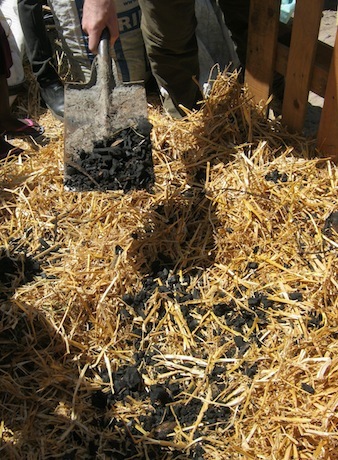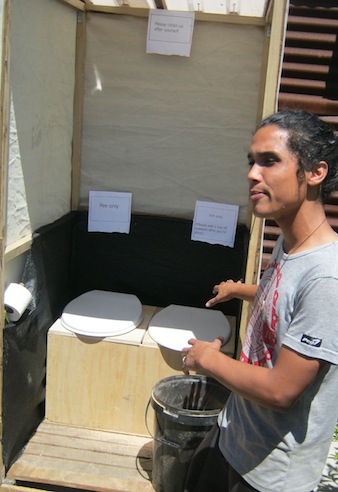Dear Reader, in this age of AI created content, please support with your goodwill someone who works harder to provide the human-made. Sign up at the top of the lefthand column or bottom of this page. You will receive my hand illustrated monthly newsletter RESTORE NATURE and access to the biodiversity garden design course as I write...and nothing else, I respect your time. I am also removing the advertizing as best I can as its become intrusive inappropriate and pays me nothing.
improve your garden soil with organic fertilizers
I learned to make a range of organic fertilizers at a recent Guerilla House workshop
 Biochar will get charged up in this hot compost pile
Biochar will get charged up in this hot compost pileFertility magic from permaculture:
a key workshop that opens the door to many other permaculture topics, but also unlocks the fruitfulness of your garden
I went to this workshop because I wanted to see the Khanyisa project, stimulated by the photographs Guerilla House has been publishing on facebook. The other workshop on the same weekend, a propagation workshop ‘food must fall’ was a fantastic inspiration, when I attended it a few months ago. As I had already attended that one, I decided to try ‘make it fertile’. It sounded very basic, and because I’ve been gardening so long I was curious what new methods it could offer, but a little blase. I could not have been more mistaken in my attitude. It is a key workshop which ‘opens out’ and leads to so many other topics in permaculture, if not the whole of permaculture.
If you use the Guerilla House free download sent us afterwards, and follow the links they provide and the research that follows on that a lot will open up for you. Soil ecology, composting and soil additives, fermentation, carbon cycles, plant mutualisms, grey water processing, and water wise garden management are just some of the topics which press hard on the heels of this workshop’s subject matter.
 Workshop attendees and Josh from Guerilla House at the board in some temporary shade
Workshop attendees and Josh from Guerilla House at the board in some temporary shadeThe site and the projects
The lovely site, with some adult fruit trees, many young saplings and sunken beds organized in a wheel pattern is the home of the garden project, Khanyisa, a collaboration between Guerilla House and members of the Langa Rasta Community, namely Zozo Mohoto, Vile Mgudlwa, DJ Simple and Ndumiso Sibindlana. The garden is called 'Rasta in the community' and it adjoins a shop called 'The Shelta'. Other attendees at the workshop were urban farmers from Khayalistsha and Gugulethu who are involved with the slow food movement, eco rapping and spreading the message of green living. There were two overseas students who research on soil biology and ecology respectively and came to learn more about permaculture soil management, and then yours truly, green blogger and gardener.
 The beautifully laid out sunken beds at Khanyisa. Mulching with wood chip and straw introduces organic fertilizers to the soil as the material decomposes
The beautifully laid out sunken beds at Khanyisa. Mulching with wood chip and straw introduces organic fertilizers to the soil as the material decomposesMaking organic fertilizers is like making earth magic
It was a quite spell binding day of making fires and concoctions to feed the invisible life under our feet. This kind of knowledge is fun to learn, hands on, engages all the senses and the mind, and made everyone excited and curious. I learned of earning opportunities, and more ways to close the recycling circles to reduce waste and produce abundance. I guess I should have known it would be so exceptional. Fertility of the soil has fascinated humans since the dawn of time, we’ve even made fertility beliefs into religion, and the knowledge from this workshop was thrilling in quite a profound way. I cannot relay all of the many topics that were covered, and will just refer you to other pages of mine if there is duplication.
In a nutshell, organic fertilizers add life
We learned first about different soil types, and a few simple tests that help the gardener, such as testing for pH with litmus from the chemist, and a drop test with peroxide, for the organic content in soil. Add organic material and life is the gardener’s mantra, but especially the permaculture gardener’s. We learned how to do this in some quite marvelous ways, from mulching to cover crops, biochar, effective microorganisms (EM’s), humanure composting and liquid manures.
 seeds for scattering: cover crops are an excellent way of improving your soil and adding organic fertilizers
seeds for scattering: cover crops are an excellent way of improving your soil and adding organic fertilizersPlants that add organic fertilizers to soil
We mixed a range of seeds for strewing on the beds, legumes, mustard, sesame and oats are good for this. Most can be bought at spice shops, Once the cover crops come up, chop n drop or cut and harvest. Plant dynamic accumulators like comfrey. We received a free download after the workshop with a list of about twenty species.
Things that once lived, that add life
You can mulch with nearly any plant matter. It cools soil, slows evaporation, harbours friendly organisms, adds organic content and protects soil life by avoiding tilling. We made hot compost, with straw, horse manure and biochar, or hard black but thoroughly burned charcoal. More on this later. Compost or soak biochar in fertile liquids before putting it in soil as it is so absorbent it would remove the nutrients from the soil if it was not already charged.
 water feeds the microbes, who make the organic fertilizer
water feeds the microbes, who make the organic fertilizerEffective micro organisms make organic fertilizers effective
I was utterly fascinated to learn some simple forms of EM culture. We cannot digest or absorb food properly without our own gut flora and the soil needs it too. Without microbes the soil is dead and unable to supply food to plants in a plant friendly form. Permaculture takes the nurturing and reproduction of soil bacteria very seriously.
We made EM’s based on bokashi inoculum, which is mainly a special yeast, as well as wild strains in the soil, and lacto bacteria in milk. They were fed with molasses, bran, cooked and uncooked rice. Wild bacteria from the soil had been cultured in a sock full of boiled rice buried in the garden a while previously. It was the smelliest sock I have ever had the pleasure of encountering, by quite a distance.
Worm farming is compact, neat and odour free, much less strenuous than making hot compost and has a range of powerful soil benefits in including available EM’s. I already have an article on vermiculture, and here is a good website. Liquid manures from weeds are fantastic and easy to make organic fertilizers. They can involve a short soak to leach nutrients from the plants, or a long fermentation to extract the nitrogen for fertilization and produce EM’s for the garden. The Guerilla House free downloads listed 11 different organic liquids that feed plants or enhance the garden’s soil life.
If you gotta go, you may as well go green
Towards the end of the workshop we had a viewing of the twin seater compost loo on the property, which was also recently built. Unlike some other simple compost bucket systems it’s a seperating system, accomplished by shifting from one seat to the other. The volume of pee produced every day is much larger and is relatively sterile, whereas poo needs hot composting and ideally to wait a year before being put on food plants which are eaten raw, where there is danger of contact with the compost. They can be processed and utilized in different ways and mixing them can be counterproductive. Both buckets use sawdust to balance the C:N ration for composting and reduce odour.
Wonderful biochar, the catalyst of organic fertilizers
Finally we made biochar in an earth pit and in a rocket stove designed from recycled materials by Imraan’s dad.
Reading an artice on this topic by scientist Kelpie Wilson, from a link in the workshop download, was really interesting. I learned the secret of biochar’s special properties as a soil additive and ‘fertilizer’ apart from its other myriad uses. These are cation exchange which influences many aspects of soil chemistry and helps it retain nutrients, and and a huge surface area that can house and protecting micro organisms. As the wood burns, most other elements are driven off, and what is left is almost pure carbon, necessitating rebonding into one form or allotrope out of the diverse geometry of pure carbon crystals. The carbon rings attach to each other to form sheets as in the crystal structure of graphite, but instead of being flat, and sliding over each other, they are folded to form what looks like a honeycomb under the microscope, maintaining rigidity and much of the outward form of the original wood. Burned just right, biochar does not decompose for hundreds of years, and has created man made fertile soils, like Terra preta in the Amazon.
The char-fire becomes incredibly hot, and Imraan’s machine has a wooden handle so that the cladding of corrugated iron can be shifted to close off the airholes. Cutting off oxygen after the wood has charred is necessary to prevent it disintegrating into ash completely.
Both fires blazed in the afternoon heat and we and went home tired and happy having been toasted both sides and satiated with interesting information.
 millenia of veld fires cause our sand to reject water, and charcoal makes it permeable again
millenia of veld fires cause our sand to reject water, and charcoal makes it permeable again------
home page for links to all kinds of natural gardening knowledge
------
fertility and soil restoration and conservation
------
a graphic version or picture rich album made of this workshop
Restore Nature Newsletter
I've been writing for four years now and I would love to hear from you
Please let me know if you have any questions, comments or stories to share on gardening, permaculture, regenerative agriculture, food forests, natural gardening, do nothing gardening, observations about pests and diseases, foraging, dealing with and using weeds constructively, composting and going offgrid.
SEARCH
Order the Kindle E-book for the SPECIAL PRICE of only
Prices valid till 30.09.2023
Recent Articles
-
garden for life is a blog about saving the earth one garden at a time
Apr 18, 25 01:18 PM
The garden for life blog has short articles on gardening for biodiversity with native plants and regenerating soil for climate amelioration and nutritious food -
Cape Flats Sand Fynbos, Cape Town's most endangered native vegetation!
Apr 18, 25 10:36 AM
Cape Flats Sand Fynbos, a vegetation type found in the super diverse Cape Fynbos region is threatened by Cape Town's urban development and invasive alien plants -
Geography Research Task
Jan 31, 25 11:37 PM
To whom it may concern My name is Tanyaradzwa Madziwa and I am a matric student at Springfield Convent School. As part of our geography syllabus for this
"How to start a profitable worm business on a shoestring budget
Order a printed copy from "Amazon" at the SPECIAL PRICE of only
or a digital version from the "Kindle" store at the SPECIAL PRICE of only
Prices valid till 30.09.2023











